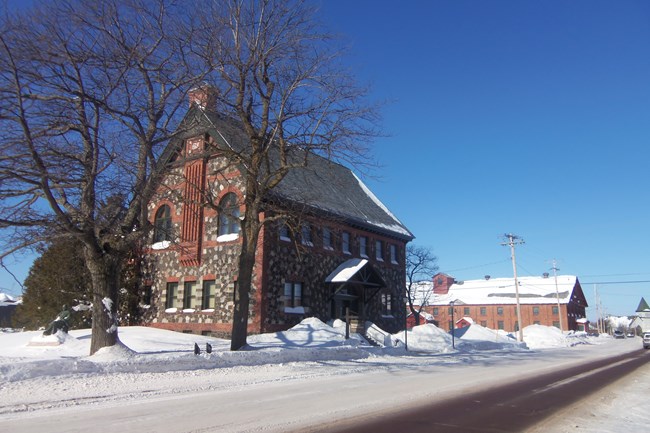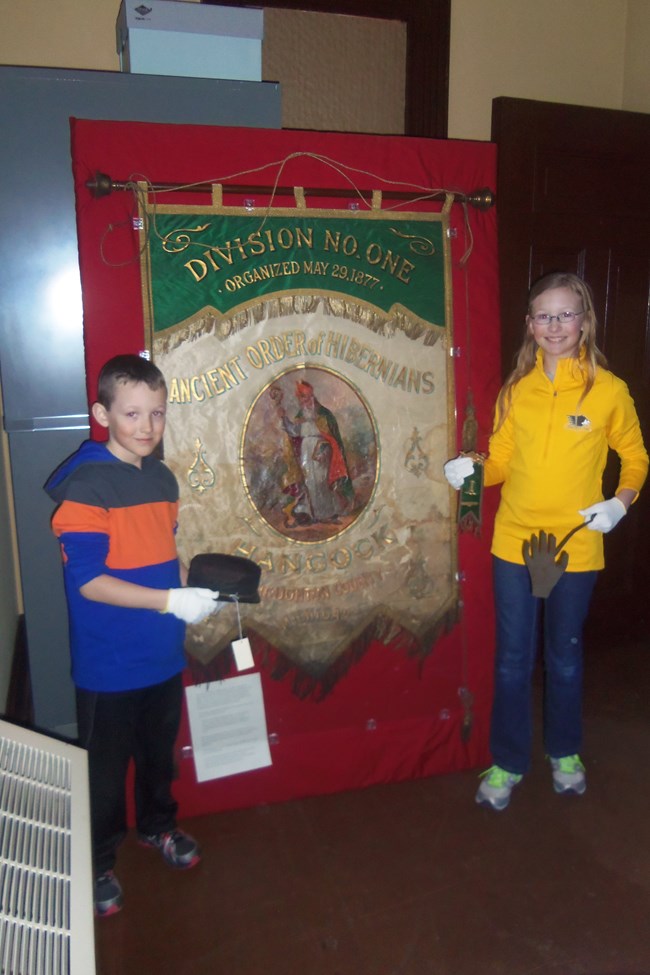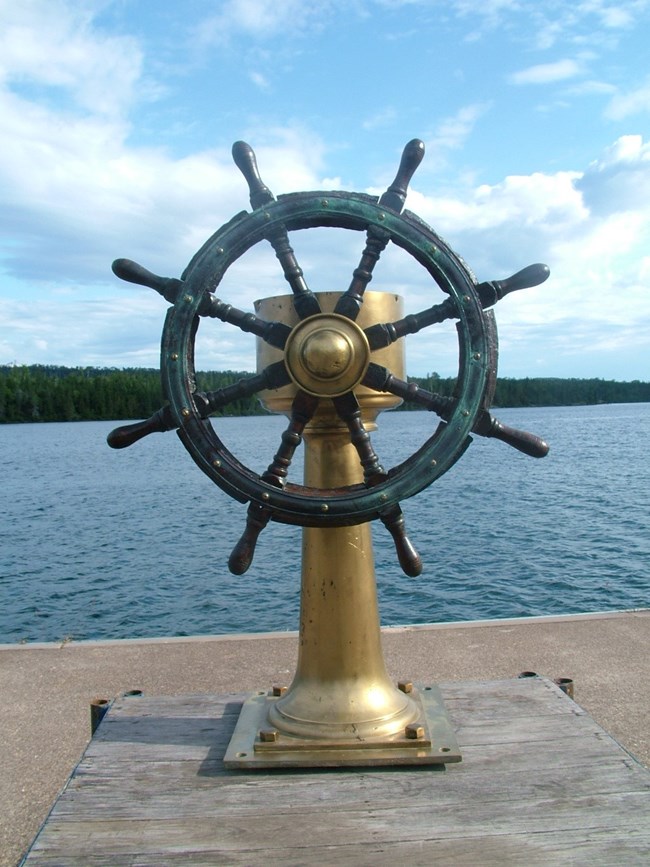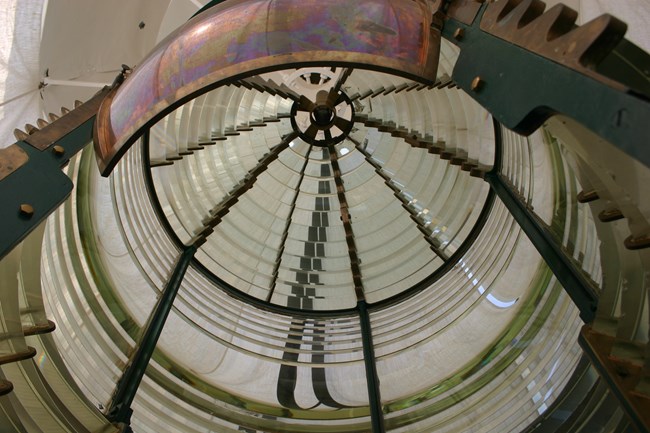
Lake Superior Collection Management Center EstablishedWhat do the national parks of south Florida have in common with the national parks of Lake Superior? As it turns out, more than just water and beautiful white-sand beaches.In January of 2014, the superintendents of Isle Royale National Park, Keweenaw National Historical Park, and Pictured Rocks National Lakeshore signed a charter creating the Lake Superior Collection Management Center (LSCMC). The LSCMC manages the museum and archival collections of the three Michigan parks. The LSCMC is modeled after the South Florida Collection Management Center, which manages the collections of the five parks in south Florida. Why did the superintendents sign the charter? In 2006, Congress directed the National Park Service to consolidate museum collection storage nation-wide,making museum operations more cost-efficient, while meeting professional museum preservation and protection standards. Keweenaw National Historical Park was selected as the home of the LSCMC based on the museum and archival facilities and professional staff already available at the park in Calumet. Facilities include the Keweenaw History Center, an archival storage, work, office, and research facility in the historic Calumet and Hecla Mining Company (C&H) Public Library and the historic C&H Warehouse #1, a museum storage facility, both on Red Jacket Road in Calumet. Comprehensive rehabilitation is planned for both buildings, including restoration of select spaces, upgrades of building systems, accessibility improvements, life-safety and security systems, and other upgrades to accommodate the museum and archival programs for the Lake Superior parks. Museum staff at the LSCMC include Curator, Brian Hoduski, Archivist, Jeremiah Mason, and a part-time Museum Technician (soon-to-be filled as of press time), as well as additional seasonal staff, interns, and volunteers. Other positions will be filled as future funding allows. Following the South Florida model, the LSCMC is not only a collections storage facility for Michigan’s Lake Superior Parks, but also an active research facility. Center staff administer the collections as well as physically caring for them. Staffing costs are shared by the three parks, and LSCMC staff actively engage other resource managers from the parks in making decisions about the care of the collections. Center staff provide reference service to other staff at the three parks, as well as to the general public. Collections at the LSCMC from the three participating parks totaled 2,448,409 items at the time the center was established. This represents 19.6% of the collections of the 60 parks in the National Park Service’s Midwest Region, and 1.5% of the National Park Service’s collection overall. The first step in consolidating collections storage for the Lake Superior parks was accomplished in May of 2015 when collections from Pictured Rocks National Lakeshore were moved from Grand Marais to the Isle Royale museum storage facility in Houghton. Although the warehouse in Calumet won’t be rehabilitated as museum storage space for a number of years, this early move of the Pictured Rocks Collection was necessitated by storm damage to the roof of their former home in Grand Marais. Further elements of the plan for the LSCMC will be phased in as funding allows. 
Hibernian Material Acquired at Keweenaw National Historical ParkThe Irish came early to the Copper Country. Many left early as well, leaving little trace of their presence to survive to the current day.Many Irish immigrants worked at the Quincy Mine, and settled in nearby Hancock, where they formed Division No. 1 of the Ancient Order of Hibernians for Houghton County. By 2014, their hall on the second floor of the building at the southeast corner of Quincy Street and Montezuma Park, now owned by Tom Ruonovaara, had long sat empty and unused. However, on a cold Saturday in February of that year, Tom allowed representatives of the City of Hancock to salvage any historical material that might still be left in the building before it was renovated. Then-city council member John Haeussler passed his children, Maggie, then 9, and Jack, then 6, through a scuttle in the ceiling of the hall to City Manager Glenn Anderson in the attic, where they discovered a treasure trove of Hibernian regalia, banners, ribbons, and other lodge items. In 2015, the city arranged for these materials documenting the Irish in the Keweenaw to be acquired by Keweenaw National Historical Park and preserved for future generations. Donating to Lake Superior CMCThe national parks of Lake Superior were established to preserve and interpret the nationally significant natural and cultural resources of the region.Some of these resources are too big to miss – including cliffs and forests, lakes and streams, lighthouses and shaftrockhouses – but the NPS also preserves smaller-scale resources such as biological specimens, miners’ lunch pails, commercial fishing nets, historic business records, and family photographs. The primary purpose in collecting these items and others like them is to preserve them for posterity. The objects and archives are also available for research use, and contribute to educational exhibits, such as the Risk and Resilience exhibit at the Calumet Visitor Center. However, these secondary uses are always carefully managed so that the primary goal of preserving the museum objects and archives is not compromised. Many items in the collections were donated by current and former Upper Peninsula families who wished to see their own family history preserved, and others who wanted to contribute to the broader understanding of the history of these special places. The NPS is very grateful to donors for their foresighted generosity. Donating material to a professionally managed museum or archival repository will ensure that the donated items will be properly cared for in years to come. Professional repositories in the Upper Peninsula include the Central Upper Peninsula and Northern Michigan University Archives, found online at www.nmu.edu/archives/, Michigan Technological University Archives and Copper Country Historical Collections, found online at www.mtu.edu/library/archives/, Finlandia University Finnish American Heritage Center Archives and Museum, found online at finlandia.edu/FAHAM, and the Lake Superior Collection Management Center at Keweenaw National Historical Park, found online at www.nps.gov/kewe. Each institution has a different mission and policy for selecting material they will collect. Please contact them directly if you have any questions. If you are interested in donating material to the LSCMC, please contact Chief of Museum and Archival Services and Museum Curator Brian Hoduski at (906) 483-3026 or brian_hoduski@nps.gov, or Archivist Jeremiah Mason at (906) 483-3032 or jeremiah_mason@nps.gov. 
Helm from Shipwreck Algoma to be Exhibited at Isle Royale National ParkThe steamer Algoma was blown off course in a fierce gale on Lake Superior and wrecked on Mott Island at Isle Royale on November 7, 1885. One hundred and thirty years later, the helm from the Algoma will be displayed in the Isle Royale shipwreck exhibit at the Rock Harbor lighthouse.The Algoma was owned by the Canadian Pacific Railway. It carried both passengers and freight. On its last voyage, the Algoma sailed from Owen Sound on Lake Huron for Port Arthur (present-day Thunder Bay), Ontario. The ship broke in two when it wrecked, and approximately 45 people perished, representing the largest loss of life in one incident on Lake Superior to date. Fourteen of those aboard the Algoma survived the wreck, including the captain, John Moore. After the incident, Moore was acclaimed as a hero for keeping his cool and rescuing many of the passengers and crew. John Malone, keeper of the Isle Royale lighthouse on Menagerie Island at Isle Royale, noted in his log that debris from the Algoma was seen floating in the waters of Siskiwit Bay in the days following the wreck. The helm, however, remained with the wreck until it was recovered by NPS tug boat captain Dick Metz in the 1960s. Metz was an avid SCUBA diver at the time, with experience diving many of the wrecks at Isle Royale. In 2011, Metz returned the helm and a number of other shipwreck artifacts to Isle Royale National Park. In 2015 a special exhibit case will be fabricated to house the Algoma helm. The helm will be displayed near a window at the Rock Harbor Lighthouse with a view to the northeast toward the site of the wreck on the south shore of Mott Island. Today, while divers are encouraged to explore and enjoy underwater shipwrecks, removing artifacts from the wrecks is strictly prohibited by law. Doing Research at Lake Superior CMCArchival collections at the Lake Superior Collection Management Center include collections from Isle Royale National Park, Keweenaw National Historical Park, and Pictured Rocks National Lakeshore. Collections include National Park Service records, and acquired historic business records, organizational records, personal and family papers, and photographs. If you are interested in doing research at the Lake Superior CMC, please contact the center archivist to make an appointment.The Lake Superior Collection Management Center Archives are located in the Keweenaw History Center, in the historic Calumet and Hecla Mining Company Public Library building at the southeast corner of Red Jacket Road and Mine Street in Calumet. Plans for the rehabilitation of the historic library building include changes to allow for universal accessibility. In the meantime, please notify center staff if you are not able to navigate stairs, and they will arrange accomodations for you in another building. If you are interested in doing family history research in the Keweenaw, the best place to start is Michigan Technological University Archives. Michigan Tech holds the majority of the records available from the Calumet and Hecla Mining Company and the Quincy Mining Company, including employment records. They also have the most complete run of Houghton County directories available in one location, in addition to many other collections. The Michigan Tech Archives are open Monday through Friday from 10AM to 5PM, and are located in the lower level of the J. R. Van Pelt and Opie Library on the Michigan Tech campus in Houghton. Walk-ins are welcome. Please visit the Michigan Tech Archives website at http://www.mtu.edu/library/archives/ for more information. For a guide to collections at Keweenaw NHP, researcher forms, and additional information, please visit the Keweenaw NHP website at http://www.nps.gov/kewe. Click on Learn About the Park, then on History and Culture, and then on Collections. 
From the Collections of Pictured Rocks National Lakeshore:For more than 150 years, ships carrying copper, iron, grain and other commodities have passed closely by the wild shorelines of present-day Pictured Rocks National Lakeshore. Storms, fog, reefs, icy waters, and uninhabited cliffs posed real dangers to those vessels, particularly in the years between the Civil War and World War II.This French-manufactured 3rd-order Fresnel lens shone a steady light over Lake Superior for over 80 years, warning ships away from the dangerous reefs of Au Sable Point. The isolation experienced by the succession of lighthouse keepers and their families who served at Au Sable can still be sensed there today in the lack of modern sounds, in the starry skies, and in the many moods of the world's largest freshwater lake*. This lens represents the close connection between the land and the lake and the people bold enough to live their lives on the wild and wonderful shorelines of Lake Superior. Due to advances in communications and navigation technology, in 1958 it was determined that the Au Sable Light should be automated. The lens was removed and replaced with a battery-powered optic. In 1996, the lens was returned to the lantern room at Au Sable, where it is exhibited for park visitors today. *by surface area |
Last updated: May 27, 2022
